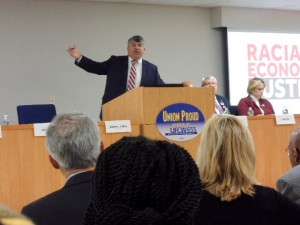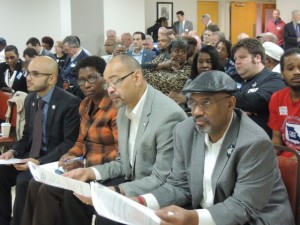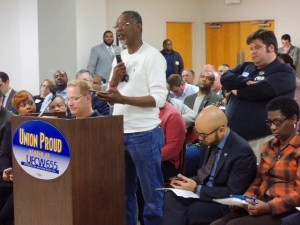
By TIM ROWDEN
Editor
Ballwin, MO – In a day-long, sometimes uncomfortable meeting, national and local Labor leaders, and rank-and-file members, gathered at the UFCW Local 655 hall here to discuss race and economic issues with local union members as part of the AFL-CIO’s Labor Commission on Racial and Economic Justice.
At a time when the Labor Movement and communities of color are under serious attack, the Commission is exploring racial issues within the Labor Movement through in-depth conversations with union members across the country. Similar meetings have been held in Cleveland, Oakland and Boston.
“We are a union family. And families must be honest with each other,” AFL-CIO President Richard Trumka said in opening comments to the assembled crowd of national and local union leaders and rank-and-file members. “We cannot afford to look the other way.
“Combatting racism really is a Labor issue,” he said. “It has to be because it’s all around us.

“Corporations and politicians use race to divide us, to pit worker against worker, to hold us down, and to keep more money and power for themselves,” Trumka said. “So eradicating racism, and other forms of bigotry, is not only the moral thing to do, it is the smart thing to do.
“Addressing racism will help us win better wages, and benefits for all working people. And it will make us a stronger political force, so we can tackle Friedrichs (Friedrichs v. California Teachers Association currently pending before the U.S. Supreme Court) and right-to-work.”
(Stay up-to-date on the latest Labor news by signing up for our free weekly email newsletter!)
United Steelworkers Vice President and Co-Chair of the Commission Fred Redmond said “In the Labor Movement we share a common desire to not just lift up our own members, but to uplift all working people. We do that through collective bargaining, empowering our members and political action. But we also know that when we are divided we are weak, and that to protect the rights of all working people, it’s essential that we must connect with one another. We have to reach out into the community. We must be part of a broader movement, for social, economic and political justice. That’s the only way we’re going to survive is if we connect with the broader community on issues that are important to all working people, whether you carry a union card or not.”
LABOR HAS TO BE THE LEADER
“We need to learn to work together,” said David Cook, president of UFCW Local 655. “Until we learn to work together as a force, we are going to continue to come under attack on labor, racial and economic issues.”
Jake Hummel, Missouri’s House minority leader and secretary-treasurer of the Missouri AFL-CIO, said race is an essential element in the Labor Movement’s efforts to lift up all working people.
“Labor has to be the leader on all fronts,” said Hummel, a member of IBEW Local 1. “We can’t just fight for workers’ rights and economic issues without addressing racial justice. We have to address all of these things.”
PROGRESS AND OBSTACLES
Pat White, president of the St. Louis Labor Council, noted the strides that have been made, including the St. Louis Building & Construction Trades Council’s BUD (Building Union Diversity) program, a seven-week program designed to help prepare minorities and women for a career in construction by exposing them to the skills requirements of several different trades. The seven-week program, which started in 2014, has graduated 33 participants with 88 percent finding jobs indentured to union apprenticeship programs.
Similarly, Painters District Council 58, spanning St. Louis and Southern Illinois, has created a training program for disadvantaged youth – the Advanced Skills Workforce Center (ASWC) – to provide essential training and related support to disadvantaged youth, particularly youth of color, to find a lifetime career.
“We know it’s important to get more inclusive in the Labor Movement,” White said. “The Building Trades have made tremendous strides towards making our workforce more inclusive. We have come a long way but there is still a long way to go. It’s important to keep communicating.”
The BUD program and the Painters’ Skills Workforce Center are signs of progress, said Lew Moye, UAW Local 110 retired and president emeritus of the St. Louis Coalition of Black Trade Unionists.
“That is progress as it relates to inclusion,” Moye said. “But so much more is needed, and we cannot declare mission accomplished.”

Mark Esters, president of the Coalition of Black Trade Unionists and an organizer for CWA 6355, said, “Whites in St. Louis out-earn Black counterparts in every area, regardless of educational attainment.”
That’s a problem that Labor and social justice activists need to address, he said.
“We have not done the work as union officers and leaders and activists that we need to do,” Esters said.
Jeff Aboussie, executive secretary-treasurer of the Building Trades Council, said part of the challenge is employers, who often will hire minority workers to meet specific job targets only to lay them off as soon as that job is completed.
“How do we incentivize contractors to retain people, not just hire them for a job that has a goal on it, and move them from job to job to job?” Aboussie asked. “The best way we can do that is to give them a well-trained man or woman.”
NEXT STEPS
The Commission is continuing to seek input and plans to make recommendations over the coming months for improving practices within local Labor bodies that build solidarity among white members and members of color, and expose practices that undermine or obstruct solidarity and constructive relationships.
Another meeting is being held this week in Minneapolis.
To share your views with the Commission, visit lcrej.aflcio.org.

